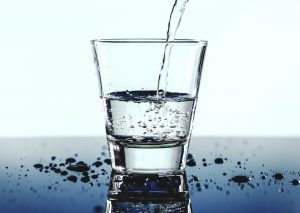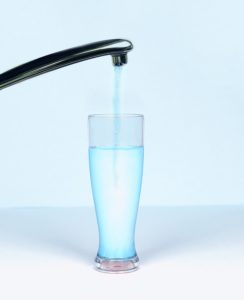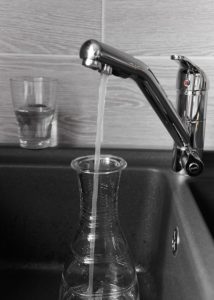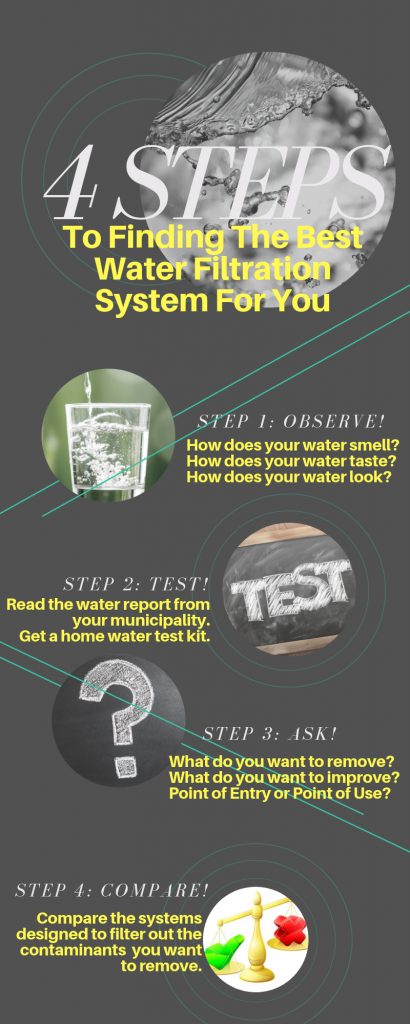All You Need To Know About Water Filters
Water is the building block of all life as we know it. Every living creature from our planet requires it to sustain life. Without it we would perish, but you can’t just drink water straight from just any source.
Our early ancestors recognized the dangers of drinking from contaminated sources of water and they developed many methods to render such liquids safe. From catching rainwater, using the earth to purify water by digging wells, or even brewing weak alcohol to render pathogens inert, mankind has come a long way in refining water purification technology.
Contents
What is Water Filtration
 Water filtration is the part of the purification process which soaks up the unwanted debris within a given source of water. While this method by itself doesn’t render contaminated water safe, it is generally used in conjunction with other techniques to render liquid sterile. The reason for this is that filtration is unable to completely remove pathogens that are too small to be stopped by the filtering material.
Water filtration is the part of the purification process which soaks up the unwanted debris within a given source of water. While this method by itself doesn’t render contaminated water safe, it is generally used in conjunction with other techniques to render liquid sterile. The reason for this is that filtration is unable to completely remove pathogens that are too small to be stopped by the filtering material.
So this brings up the next question.
Why Do We Need Water Filters?
If filtration alone isn’t enough to render water safe, shouldn’t we purchase a system that does?
To answer that question, it really depends on your situation. Water is an important resource that society needs to keep chugging along and is serious business. In most developed countries, water treatment plants work day and night to render water safe for drinking, bathing, and other uses. This means that for many of us, getting to a source of safe drinking water is as easy as placing a cup under the tap. But despite the best efforts of water treatment and distribution centers, there’s still unwanted debris and chemicals that get through due to how the water is pumped to our homes.
Pipes.
Everything the water pumped from the treatment plant touches adds a little bit of squick to it as it travels towards our homes. Some of these pipes could be decades old, possibly rusty or even made of lead depending on when the pipes were laid. Other older pipes may be made from iron or lead, causing flakes of rust to peel off and be sent straight towards your faucet. Even modern pipes that are either made of corrosion resistant copper or plastics can carry heavy metals or unwanted microorganisms into the deceptively clear water pouring out of your tap.
It’s not just the pipes connecting to your home that you need to worry about either. The pipes in the walls of your home aren’t controlled and maintained by the government, and depending on how old your home is, the pipes can be veritably ancient. Regardless of how well you clean the visible portion of your faucet to a shiny, mirror sheen, there isn’t much you can do about the internals short of replacing your piping.
Something else you need to worry about is how the treatment plants are purifying your water. Like your local swimming pool, one of the most frequent ways of rendering microorganisms in water safe is by adding chlorine to it. This method kills most pathogens in water, so it seems like an effective way of treating your drinking water even if it tastes a little funny, right?
Unfortunately there are nasty little bugs out there that can resist chlorine. If that wasn’t enough you need to worry about where exactly the pipes leading to your home are laid. Pesticides used before the mid 1900s contained a variety of heavy metals which remain dangerous for long periods of time. If any of these pesticides were used in your area, it’s possible that they could enter water pipes through leaks around contaminated soil.
So, is a water filter sounding like a reasonable purchase to mark down on your shopping list yet?
Types of Water Filters
Within the United States, there are several commonly used types of filters.
Activated Carbon Filters
This type of water filter is the most popular for the purpose of home use. The reason why it’s so common is because it’s cheap, easy to use, and doesn’t take up much space at all.
What happens when water runs through these filters is that contaminants get stuck against the structure of the carbon. This occurs because carbon is made of many, tiny ridges that contaminants find themselves falling into. Essentially activated carbon filters act like a huge sponge for the comparatively tiny microbes and chemical molecules inside contaminated water.
The downsides to this type of filter is that it can’t block some types of contaminants. Sodium, fluoride, nitrates, and some microbes are resistant to absorption via carbon so they’ll end up slipping right past the filter. Another thing is that the absorbant property of activated carbon is finite. This is why you see Brita filters being sold in packs and why they need to be replaced after a period of use.
Pros
- Inexpensive.
- Good at filtering dirt, chlorine, odd tastes, and smells.
Cons
- Bacteria can grow in the filter.
- Does not soften water.
Distillation Filters
 This type of filtration is synonymous with all of those reality TV survival shows where someone ends up on an island and has to make a solar still to survive. What this filter does is heat water until it starts steaming and catches the condensed water in a separate container.
This type of filtration is synonymous with all of those reality TV survival shows where someone ends up on an island and has to make a solar still to survive. What this filter does is heat water until it starts steaming and catches the condensed water in a separate container.
The idea behind this method is that water begins to boil at a lower temperature than most chemical contaminants. Microbes can’t survive being boiled and chemicals that start to evaporate at a higher temperature are left stuck in the original reservoir while clean water is transferred.
Not that this is a foolproof method of filtration as there are chemicals that boil before water. Said contaminants will just be carried along with the water into the new container. Some bacteria are even hardy enough to survive boiling temperatures long enough to hitch a ride.
Pros
- Gets rid of metals in the water.
- Softens the water.
Cons
- Fairly large.
- Can make water taste salty.
Ion Exchange Filters
What makes these filters work is the zeolite beads inside them. The sodium ions within the beads interact with the calcium and magnesium in water. What the little beads then do is trade its own sodium ions in exchange for the calcium and magnesium, filtering them out of the water. The purpose of this is to reduce the harsh taste of limescale since the majority of it is made up of magnesium and calcium.
Like activated carbon filters, ion exchange devices are affordable and cheap to purchase and maintain. They’re at their most effective when used for the purpose of softening your water.
The downside to this though is the salty taste that’ll be applied to the resulting water. It’s not undrinkable by any means, but the taste does take some getting used to. On top of this, ion exchange doesn’t rid the water of other chemicals and microorganisms.
Pros
- Inexpensive.
- Small sized.
Cons
- Not as good at filtering contaminants.
- Gets rid of important minerals.
Reverse Osmosis Filters

Instead of a single filter, these devices are usually made up of multiple filters. These filters are divided into three categories, pre-membrane, semi-permeable membrane, and post-membrane filters. Of these, many reverse osmosis filters use a total number of five.
The first of three pre-membrane filters to block out larger debris such as dust and rust. The second is generally a carbon filter used to stop harmful chemicals like chlorine. The third is also a type of carbon filter, but uses a denser source of carbon to stop the smaller contaminants that get past the first two filters. The reverse membrane filter, which is the fourth, stops contaminants depending on their ionic charge, size, and molecular weight. By the time the water reaches the fifth, post-membrane filter, 99% of the contaminants have been weeded out. The final filter is meant to stop whatever is left and get rid of unwanted tastes or smells. Some models even come with UV lights to zap whatever pathogens are left into harmless, invisible floaters.
In terms of household filters, reverse osmosis filters are one of the best systems you can buy. While expensive compared to other options, they still remain affordable and are able to tackle a wide range of possible obstacles.
About the only other negative besides its price tag is that it does almost too good of a job filtering out contaminants. While doing so, some beneficial minerals may be blocked by the filtering process. This can make your water taste bland as it is the minerals in water that imparts flavor to water.
Pros
- Ensures water is 95 – 99% pure.
- Can filter large volumes of water.
Cons
- Water can taste bland.
- Important minerals can be lost.
Ultraviolet Filters
These types of filters use UV light to sterilize water sources that are teeming with pathogens like bacteria and viruses. UV filters are extremely efficient at eliminating microorganisms. The reason for this is that at certain wavelengths, UV causes a mutagenic effect that breaks molecular bonds within DNA. Basically what happens is that the microorganisms being filtered are bombarded by a level of radiation that is harmless to humans, but are deadly to microbes.
Of course the downside to this system of filtration is that it does nothing to filter out chemicals are debris. This is why usually UV filters are paired alongside another type of water filter.
Pros
- Effective at destroying viruses, bacteria, and other pathogens.
- Small in size.
Cons
- Doesn’t filter out chemicals or debris.
- Requires another type of filter for best effect.
Finding the Right Filter for You

Now that you know that each type of filter has its strengths and weaknesses, you need to know how to make a choice based on this information. As you can see, some filters are better at removing certain types of contaminants than others. Now we need to figure out exactly what is in your water by testing it.
Using Your Senses
The simplest method of determining the quality of your water is by using your senses. It’s not a completely accurate way to judge what kind of filter you need to buy, but all it costs is a little bit of your time. You’ll probably be pleasantly surprised at how much information you can gather just by using the senses you were born with!
Sight
Like anything else, it’s your eyes that’ll let you know if anything about your water is off at first glance. Fill up a clear glass with water and hold it up to a light source.
Do you see anything that jumps out at you? Is the water cloudy or are there particles floating in the glass? If you see flecks of red or other things that look like corroded metal, it could be that your pipes are rusted. If your water happens to be cloudy, this generally means that you have too much magnesium or calcium carbonate in your glass. If the water happens to be discolored or brownish, it could be anything from pollution, rust, mud, or anything else that can get into your pipes.
Smell
Taking the time to smell your water can tell you quite a bit about your water. Grab your glass and take a whiff of it. If you happen to smell something sulfuric, or something like rotten eggs, there’s a whole lot of bacteria growing in that water you were thinking about drinking. If the water smells like soil or something musty, that’s a sign of organic decay.
It might be that the smell is coming from your drain, however. So fill up a glass from the same tap and take it elsewhere. If your water doesn’t smell after a few minutes it’s probably time for a drain cleaning.
Test this with the other faucets in the house. It’s possible that whatever the issue with your water is, it could may only be a specific set of pipes that could be the problem.
Taste
It might seem counterintuitive to go against everything you’ve learned about putting possibly dirty things in your mouth, but where your eyes and nose fail, your tongue can be more specific.
That’s not to say you should drink anything that smells or looks questionable. If you have any reason to hesitate at all, do not swallow the water. Your taste buds are nature’s way of giving you a general indication of what you should or shouldn’t put in your mouth. If the water tastes foul, spit it back out after taking note of how it sits on your palette.
The aftertaste of bleach means your water was chlorinated as a means of a treatment. If your water tastes irony, pun intended, there’s probably more minerals than there should be in that glass. If the water tastes salty, then you’ve got sulfates leaching into your pipes somewhere.
Use a Test Kit
 While some of us may be happy enough to look at, smell, and taste a glass of water before calling the day a good one, there is another option available. Something a little bit more scientific and reassuring than a comparatively quick glance at your water.
While some of us may be happy enough to look at, smell, and taste a glass of water before calling the day a good one, there is another option available. Something a little bit more scientific and reassuring than a comparatively quick glance at your water.
Water quality test kits come in all shapes and sizes. Generally a test kit comes with little strips similar to what you’d use in chemistry class to check a liquid’s pH balance. Only, instead of testing just for pH, a test will carry multiple strips that test for bacteria, chlorine, hardness, heavy metals, lead, nitrates, nitrites, and pesticides. All you need to do is follow the directions that come with whichever test kit you choose to purchase in order to determine your water quality.
Some of you might think it’s a bit much to go through the hassle of conducting what is essentially a small science experiment, but science is fun! Possibly a little horrifying depending on what you end up discovering.
Choosing the Right Filter for You
Now that we’ve gone over the common types of filters, you should have a pretty good idea of their strengths and weaknesses. Combining that with the results of your tests, we can see about narrowing down your future purchasing options.
Smelly or Foul Tasting Water
Sometimes water just tastes or smells bad even if it’s safe to drink. Thankfully, there’s something that can be done about it in an affordable manner.
Low Budget Option
Activated carbon filters are a solid choice if your primary reason for needing a filter is the palatability of your tap water. Given their cheapness, popularity, and ease of installation, this filter will get the job done for the smallest hit to your wallet.
High Budget Option
Reverse osmosis filters are one of the most effective water filtration products you can purchase for home use while still remaining affordable. As a generalist product that is meant to stop just about anything in your water from getting through the tap, you’ll be seeing RO filters listed more than once in the coming options.
Hard Mineral Water
Eventually the minerals that cause limescale deposits to build up in your pipes are going to cause your water to grow harsh. This is a common issue in households across the United States, but there are solutions.
Low Budget Option
Personally I’ve had some success with softening water with activated carbon filters, but to be honest that’s probably just a placebo effect. What does work for sure is the ion exchange filter. They might make your water taste a little salty, but they’re effective at softening your water while remaining very affordable.
High Budget Option
Remember how I said the reverse osmosis filter is going to continue appearing? It’s being recommended here due to how good these filters are at keeping almost everything out of your water. This of course, includes the chunks of limescale clouding up your drinking water.
Bacterial Soup
I love a nice bowl of soup as much as the next person, but this is probably something I’ll pass over unless I’m dying of thirst in the desert. Fortunately, water purification technology has come a long way since mankind drank from the same watering holes used or lived in by wild animals.
Literal poo water. No thank you.
Low Budget Option
Distillation filters are an excellent option. They’ll kill most bacteria during the boiling process before the water condenses.
You could also use a UV filter here. Given that these filters were designed specifically to kill pathogens, you can only do better if you go another step above.
High Budget Option
To the reverse osmosis filter.
Again. For good reasons.
Many of these come with a UV filter as part of the package. Not only does this filter absolutely destroy viruses and bacteria, it pretty much stops everything else from getting through the pipes and into your glass.
Recapping the Bottle
Water purification has come a long way since we used to mix water with alcohol to meet our daily hydration requirements. However, even with modern water treatment plants working overtime to ensure the cleanliness of our water, there are still many avenues of possible contamination once that water is piped through to our homes.
By using a specific type of water filter depending on the quality of your tested water, you can minimize the risks of exposure to chemicals, debris, bacteria, and a number of other unwanted nasties being pumped through your pipes. Beyond keeping you and your family healthy, filters are an economically and ecologically viable alternative to buying bottled water.
Water is arguably the most precious commodity on the planet. A quick search on the internet will immediately return dozens of news articles pertaining to contaminated water and the adverse effects it can have on our health. It might only be for your peace of mind, but think about purchasing a water quality testing kit if only to see if your water is safe for consumption.
Better to be safe now and in the future rather than sick right?
Home Water Filter Pro
2102 Kirkwood Hwy Suite 222
Wilmington, DE 19805
(302) 219-7797